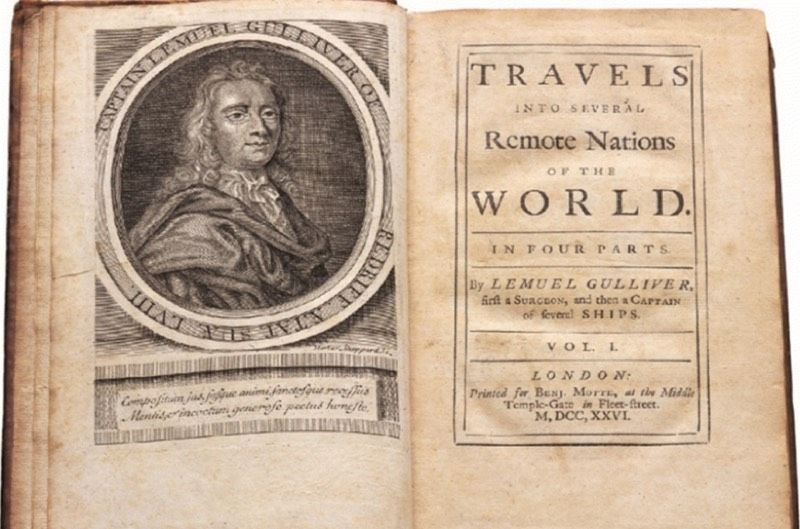
Gulliver's Travels is justly regarded as one of the best satirical novels of all time, although its author, Jonathan Swift, claimed he wrote the book "to vex the world rather than divert it." Politicians of the time were indeed vexed at being mocked in its pages. It seems the author's physiological descriptions also proved a bit vexatious, according to a charming new paper in the Journal of Physiological Sciences.
First published in 1726, Gulliver's Travels relates the fictional adventures of one Lemuel Gulliver, "first a surgeon and then a captain of several ships," according to the book's lengthy subtitle. During his voyages, Gulliver encounters several unusual species: the tiny people of Lilliput; the giants of Brobdingnag; talking horses called Houyhnhnms who rule over the deformed, uncouth Yahoos; and the inhabitants of the flying island of Laputa, who devote themselves to the study of science and the arts but have never figured out how to apply that knowledge for practical applications. Apart from its literary qualities, Gulliver's Travels provided ample fodder for eagle-eyed experts, since Swift couldn't resist going into great detail about the physiology of his fictional species, practically inviting closer scrutiny.
Toshio Kuroki, special advisor to the Japan Society for the Promotion of Science and professor emeritus at the University of Tokyo and Gifu University, read Gulliver's Travels for the first time with his book club. Having spent a long, prestigious career conducting cancer research, Kuroki immediately noticed an error on Swift's part when estimating Gulliver's energy requirements compared to those of the diminutive Lilliputians. It spurred him to look more closely at similar passages in the book and to make his own comparative physiological analysis of the fictional creatures encountered by Gulliver during his travels.
"The sizes of the Lilliputians and Brobdingnagians are close to those of rats and large dinosaurs, respectively."
Gulliver is described as being less than 6 feet tall in the book. Per Kuroki, a 2000 survey of heights across England found that the average height for men in the 18th century was around 5 feet 6 inches, so this seems about right. Apparently Swift "adopted the base of 12 in imagining these fictitious peoples," Kuroki wrote. Per Swift's text, the Lilliputians were 1/12 the size of Gulliver, while the Brobdingnagians were 12 times his size. That would make the Lilliputians just under half a foot, with the Brobdingnagian towering above everyone at just over 67 feet. Both fictional species are described as having bodies shaped similarly to humans.
Swift assumed weight would be proportional to the cube of the height, and used that to estimate the relative energy requirements of the three species. But Kuroki cites Quetelet's rule (1869), stating that weight is proportional to the square of the height. It was kind of the body-mass index (BMI) of the 19th century, and Kuroki came up with an average BMI of 23 for his analysis. That would put the average Lilliputian's weight at 1 pound, Gulliver's at 148 pounds, and the Brobdingnagians at 21,351 pounds. "The sizes of the Lilliputians and Brobdingnagians are close to those of rats and large dinosaurs, respectively," Kuroki wrote.
Whereas Swift estimated that Gulliver would need to consume the daily food requirement of 1,724 Lilliputians, Kuroki's analysis showed that food for just 42 of the tiny creatures would suffice for the adventurer's energy needs. As for the gigantic Brobdingnagians, Gulliver would only need the food consumed by 1/42 such creatures. Based on this, "the food requirement of Gulliver in the original text should be corrected after almost three centuries," Kuroki wrote. Kuroki also estimated the comparative heartbeats, respiration rates, life spans (known to roughly follow a power law), and blood pressure for the three species.

Apparently Kuroki gave a presentation on his analyses to his fellow book club members. "After my presentation, colleagues at the book club appreciated that they now had a better image of these fictitious peoples, but added that it was a unique but not necessarily proper viewpoint from which to consider this book," Kuroki wrote. "I agreed." I suspect Swift himself would have been amused by the exercise.
Swift fared a bit better in his treatment of astronomy in Gulliver's Travels. In "The Voyage to Laputa" (Part 3, Chapter 3), he notes that the astronomers of that land had discovered "two lesser stars, or satellites, which revolve about Mars." Mars does indeed have two moons, Deimos and Phobos, both found in 1877 by Asaph Hall, although Kepler had speculated about their possible existence. (Kepler may have been Swift's inspiration.) That's why a crater on Deimos is named after Swift, along with various minor features on Phobos.
DOI: Journal of Physiological Sciences, 2019. 10.1007/s12576-018-00655-4 (About DOIs).
reader comments
82